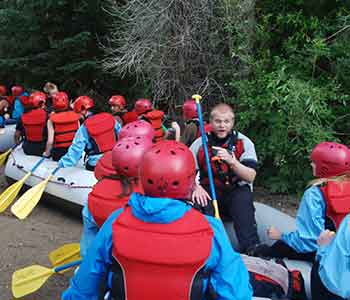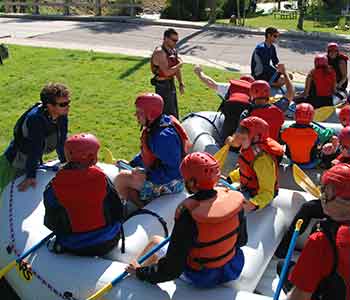Whitewater Rafting Safety Guidelines
Guest Responsibilities
Geo Tours assumes no liability for loss or damage to personal possessions. All guests should be in good health and will be required to read and sign a liability release prior to the trip. Anyone judged to be under the influence of alcohol and/or a controlled substance or below necessary fitness levels may be refused participation. Marijuana use is not permitted on the premises and on Federal Lands it is illegal. Please be considerate of your fellow guests. For your safety, GoPro cameras and similar devices are not allowed on the water while you are participating in one of our raft trips.
The purpose of this Safety Talk is familiarizing Geo Tours’ guests with essential information for their safety and enjoyment while on their raft trip.
PFDs (Personal Floatation Device)
Your PFD is possibly the most important safety item while you are on or near the water. Your Type V PFD is designed to provide you with additional floatation when you are in the water. Furthermore, it is designed to assist an unconscious individual in floating face up. Your PFD will also act as the principle method for retrieving an individual from the water in the event of a “swimmer”. Therefore, your PFD must always be completely buckled and properly adjusted (by your guide) when you are on the water.
Securing Guests in the Raft
Your raft is equipped with footholds and handholds to aid you, the guest, in staying in your raft. Depending upon your placement in the raft, you will have either a foot cone (a pocket attached to the raft’s floor) or a thwart (inflated cross tube within the raft) that will act as your foothold. The guest should place the foot that is nearest to the inside of the raft into the foot cone, or place one or both feet under the thwart. Handholds are attached to each thwart in your raft.
Remember that when encountering rapids or obstacles in the river you are most secure by leaning into the center of the raft. Your guide may ask that you paddle at certain times while traversing the river and your safety may depend upon your paddling when asked to. You can use your paddle to brace yourself into the raft. This is accomplished by a simple paddle stroke or slapping your paddle on the water’s surface (blade flat to the water).
Passengers Overboard
In the event that passengers fall overboard there are several things for the swimmer(s) to remember. DO NOT PANIC! When you surface, look around and see where you are! If you do not immediately surface because you are hitting the underside of the raft, use your hands to work your way out from underneath the raft.
- A) If the swimmer surfaces next to the raft, the swimmer should: 1) grab the line around the perimeter of the raft, 2) hand your paddle to someone in the raft and 3) face the raft and be prepared to be pulled in. Only one person should conduct the rescue. This can be accomplished by rescuer: 1) grabbing onto the shoulder straps of the swimmer’s PFD and 2) pulling swimmer onto raft by locking one’s arms and using one’s body weight while leaning backwards into the raft.
- B) If swimmer is not immediately next to the raft when they surface but is near the raft, the swimmer should use their paddle to extend their reach to someone in the raft. The rescuer in the raft can then pull the swimmer to the raft and proceed with rescue as above. Swimmer should offer handgrip end of the paddle to rescuer. NOT the blade end of the paddle.
- C) If swimmer surfaces a considerable distance from the raft and is in a section of rapids, the swimmer should assume the Whitewater Swim Position (Defensive Position). The Whitewater Swim Position is best described as: 1) face downstream with your feet out in front of you, 2) legs should be slightly bent and 3) swimmer’s nose and toes should be above the water. Imagine yourself sitting in a LAZY Boy recliner. The Whitewater Swim Position should be maintained until swimmer is rescued or until swimmer has the opportunity to get back to the raft or to get to shore. While in the Whitewater Swim Position, swimmer should attempt to take their breaths while in the low portion (or trough) of the wave. At the crest of a wave swimmer should close their mouth to keep from swallowing splashed water. Swimmer should be looking down the river for obstacles. Obstacles can include: 1) rocks, 2) manmade objects and 3) trees. Swimmer may be able to avoid obstacles by pointing their feet at the obstacles and back paddling with either their paddle or hands and arms. Similarly, a swimmer can also maneuver themselves to shore by pointing feet towards center of river and back paddling.
Whitewater Swim Position should be abandoned when the opportunity exists for self-rescue. Self-rescue can be accomplished by switching to a normal overhand swimming position (Aggressive Whitewater Swim Position).
In the Aggressive Whitewater Swim Position, the swimmer should quickly and with strong swimming strokes swim to raft or shore. If swimming to shore, swimmer should swim all the way to the shoreline and crawl from water.
Swimmer should not attempt to stand and walk while in the water! Any time a swimmer’s legs and feet are below the surface of the water, the swimmer may be risking a leg or foot entrapment. Rivers in the Rocky Mountains can be characterized as having many rocks and boulders in their channels. These rocks and boulders form many of the rapids you will encounter as you traverse the river. If the swimmer’s legs and feet are below the surface of the water, these rocks and boulders are a hazard best avoided. When the swimmers legs and/or feet become wedged between rocks and boulders, the river’s current can act to keep the swimmer entrapped and unable to free their legs and feet without aid from another. Therefore, the swimmer should elevate their legs while swimming and not attempt to walk in swift flowing water.
Strainers
Like rocks and boulders in the river channel, trees and downed trees in the river channel can entrap the unwary swimmer. Swimmers should avoid being swept into strainers at all costs. If the swimmer spots a potential strainer, they should swim strongly away from the obstacles (trees). Should avoidance not be possible, the swimmer should face the obstacles and attempt to pull themselves onto the trees. It is critical that the swimmer get their head above the obstacle and out of the water!
Rescue Ropes
Each raft is equipped with a Rescue Throw Bag. The Throw Bag has 50+ feet of rope. This device can be used to retrieve a swimmer from the water in the event that a swimmer cannot self-rescue. Your guide will spot the swimmer and yell and motion to the swimmer to expect the bag to be thrown to them. Then the guide will throw the bag end to the swimmer while holding on to and anchoring one end of the rope. Swimmer should make every effort to grab the rope. Swimmer should remain in Whitewater Swim Position and take the rescue rope over their shoulder. Once rope becomes taut, swimmer will be pulled to raft or shore while on their back. Swimmer should never wrap rope around their arm or body.
Raft and Obstacle Collisions
Your raft may collide with obstacles as you traverse the river. In most cases, this will only result in minor bumps and perhaps becoming momentarily stuck on the obstacle. In some cases, your guide may have the guests shift positions within the raft in order to free the raft from obstacles. If you are asked to shift positions, please do so immediately but safely. Always keep both legs in the raft unless your guide requests that you disembark the raft. In emergency cases where a raft is severely stuck and is in danger of being swamped or flipped, your guide will call for a “Highside”. A Highside is a demand by your guide for immediate shifting of the guest’s position to the highside of the raft.
When a raft is dangerously stuck on an obstacle, the force of the river current begins to push the raft up the obstacle. The upstream side of the raft (lowside) begins to be sucked under the water while the highside rises up and onto the obstacle. Quick action by the guests and guide can, in most cases, prevent a disaster. By shifting the load (people) in the raft to the highside, the lowside is allowed, through its inherent buoyancy, to rise above the river’s surface. This loading of the highside also stops the raft from climbing the obstacle.
Quick action is extremely important. In the event the Highside is unsuccessful, most or all persons in the raft will be dumped into the river. Likewise, the raft may be overturned (flipped) and all passengers will be dumped into the river. When the above described dumping of the raft occupants into the river occurs, the situation becomes a Self-Rescue. In a self-rescue, swim to a raft, even an overturned one, or swim to shore!
Hand Signals
A few simple hand signals can be used while on a river expeditions. These signals allow communication when voice communication may not be possible. When a guide pats the top of their head while looking at you, the guide is asking “Are you OK?” Patting your head in response signals that you are OK. If you are in distress, you should wave your paddle or hand above your head. When a guide points to one side of the river with paddle and/or arm, they are signaling you to get to that side of the river. You should signal that you understand by the OK signal (pat your head) or, if you cannot get to the indicated side of the river, that you are in distress (wave arm above head). You and your guide might work out other signals for paddle commands such as two taps for a Forward Paddle and three taps for a Back Paddle.
Paddling
You and your fellow guests will be paddling your raft down the river. You are the engine for maneuvering your raft and your guide is the steering. Please, stay attentive and watch for paddle commands. While your paddle is your friend and the means of maneuvering the raft, it is also a tool that needs to be properly handled. Always try to keep one hand on the T-grip handle of your paddle. A paddle has struck many a guest when the paddle was not properly held. In most cases, injuries are minor. Protect yourself and others by careful handling of your paddle.
Items covered in the Safety Talk should be taken seriously but do not be over-worried. Most of the mentioned emergencies will not occur during your trip. Enjoy your raft trip but try to remember the topics covered in the Safety Talk in case of an emergency.
The Staff
Geo Tours/Whitewater Raft Trips
Download Essential Eligibility Criteria.



